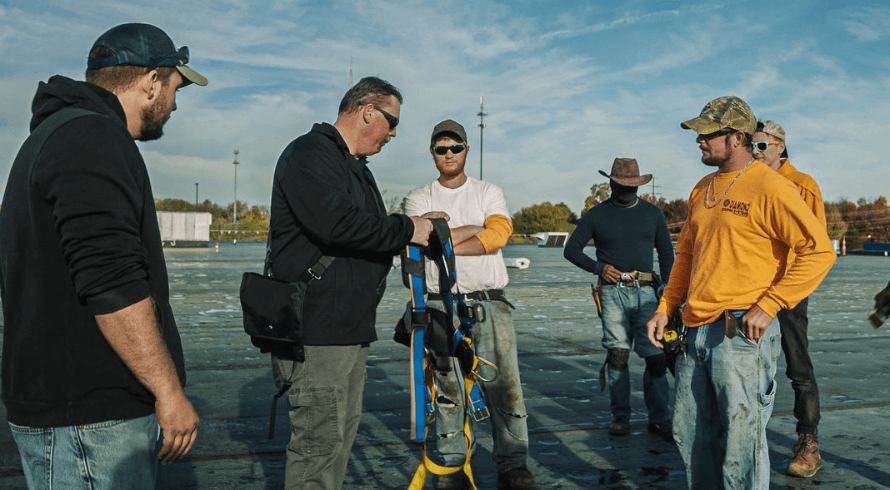Construction safety isn’t optional—but keeping up with the rules, documentation, and shifting responsibilities on a busy site can feel like a full-time job. That’s especially true when your team is juggling tight timelines, unpredictable weather, and a whole lot of paperwork. Whether you’re in Philly or the Poconos, knowing how to stay compliant (and keep your crew protected) is non-negotiable.
Below I’m going to break down what construction pros in Pennsylvania need to watch out for, what’s happening in their own backyard, and how smarter systems are helping teams get ahead.
Pennsylvania Construction and Workplace Safety Statistics
- Pennsylvania’s construction industry was responsible for the highest number of fatalities in the state in 2023, accounting for 18% of total fatal occupational injuries.
- The construction sector in Pennsylvania reported an incidence rate of 2.6 nonfatal injuries and illnesses per 100 full-time workers in 2023, 8% higher than the national average.
- According to the U.S. Bureau of Labor Statistics, 43 out of 169 fatal work injuries in Pennsylvania in 2023 were caused by falls, slips, or trips—that’s roughly one in four jobsite deaths.
- Falls, slips, and trips constituted 25% of Pennsylvania’s workplace fatalities, higher than the national average of 17%, highlighting a particular area of concern within the state.
- Since 2011, the Department of Labor & Industry has identified more than 1,250 construction contractors in violation of the Pennsylvania Construction Workplace Misclassification Act (Act 72).
- In 2024, fines totaling $1,031,398 were issued to contractors violating Act 72.
Safety Rules with a Pennsylvania Twist
We all know OSHA sets the federal baseline for workplace safety. But in Pennsylvania, there are a few extra rules in play that can trip up even seasoned contractors if you’re not careful: Act 174 and Act 72.
General Safety Law (Act 174)
Vaguest title ever, right? Enacted in 1937, Pennsylvania’s General Safety Law (Act 174, P.L. 654) establishes comprehensive safety standards for workplaces across the state. Its primary objective is to ensure that all establishments are constructed, equipped, and operated in a manner that safeguards the health and safety of employees.
This law goes beyond general best practices—requiring proper machine guarding, clear excavation supports, safe scaffolding, and more. If there’s dust, fumes, or gases involved, you either eliminate them or provide serious PPE. No shortcuts.
Construction Workplace Misclassification Act (Act 72)
This one hits contractors where it hurts: the wallet. If you’re classifying someone as an independent contractor without meeting every requirement (including a written contract), you’re at risk for big fines. And the state is checking.
In 2024 alone, the PA Department of Labor & Industry fined contractors over $1 million for violations of Act 72, after investigating 639 cases and finding nearly 1,900 workers misclassified. That’s not just a slap on the wrist.
Real Examples, Real Risks, Real Consequences
When you’re knee-deep in a project, it’s easy for safety to get buried under the day-to-day chaos. But knowing about—and understanding—the real-life incidents happening in your own backyard can be the push you need to manage safety better, and to avoid the same consequences these companies faced.
- In June 2024, a Liverpool roofing company was found to have exposed two children, aged 12 and 14, to potentially deadly falls while working on a Mechanicsburg apartment complex. Due to the lack of fall protection, an incorrectly set ladder, and nail guns in violation of federal regulations, the company was cited for five safety violations and faces $64,759 in proposed penalties.
- On August 16, 2023, employees of a Wilkes-Barre-based roofing contractor were observed working at heights of up to 27 feet without fall protection on a commercial building in Honesdale. OSHA proposed $328,000 in penalties for the violations.
- In May 2022, a Philadelphia-based roofing contractor was cited for seven willful and 11 serious violations after inspectors found employees working without required fall protection while performing sheathing and framing work. Additional violations included the use of damaged ladders, electrical hazards, lack of eye and head protection, and failure to train workers on forklift safety. Total proposed penalties for these violations are $793,290.
- In June 2021, a 19-year-old roofing worker in Neville Island, Pennsylvania, fell 30 feet through an unprotected skylight and suffered fatal injuries. OSHA found that the construction contractors willfully failed to use required fall protection systems, leading to proposed penalties totaling $335,868.
Safety Violations: Root Cause Analysis
Behind every construction site injury is more than just a momentary mistake—it’s often the result of deeper, systemic issues. While violations like failing to use fall protection or skipping safety checks might seem like individual choices, they’re frequently driven by production pressure, lack of training, or communication breakdowns. Understanding the why behind these safety failures is key to preventing them.
Bypassing Fall Protection
Falls are the leading cause of fatalities in the construction industry, often resulting from systemic issues that compromise worker safety. Key root causes include: time pressure and production demands, lack of training or awareness, and underestimating dangers.
- Production Pressure (PrP): The urgency to meet tight construction deadlines and avoid re-work can lead workers and supervisors to prioritize speed over safety protocols. Studies have shown that this pressure can cause stress, lower the quality of work, and lead to unsafe behavior, like bypassing essential fall protection to expedite tasks.
- Lack of Training or Awareness: Inadequate training leaves workers unaware of the risks associated with working at heights and the proper use of fall protection equipment.
- Neglecting Safety Measures for ‘Easy’ or Seemingly Safe Tasks: Workers may underestimate the dangers of routine or short-duration tasks, leading them to skip safety measures. This complacency increases the risk of falls during tasks perceived as low-risk.
Addressing these root causes through comprehensive training, realistic scheduling, and fostering a culture that prioritizes safety over speed is crucial to reducing fall-related incidents in construction. This toolbox talk about fall protection is a good guide to on-site communication around the hazards.
Poor communication
It sounds simple, but poor communication is behind more injuries than people think. When workers aren’t clear on what’s expected—or when they don’t feel safe speaking up—things go sideways.
A study by the Journal of Environmental Research and Public Health highlights how systemic barriers and poor communication are major contributors to safety hazards in construction. Fostering a strong safety climate and crew-level cohesion significantly improves safety communication, suggesting that addressing these communication gaps can lead to better hazard management and fewer injuries on-site.
Another U.S. study found that high-performing construction crews tend to:
- Receive formal safety updates from management at least once a week
- Engage in informal safety conversations weekly
- Participate in structured safety training sessions
- Regularly utilize all recommended safety communication methods each month

How PA Construction Contractors Can Avoid Safety Violations with Digital Tools
Let’s connect the dots. The most common causes of construction safety violations—missed fall protection, poor communication, rushed jobs, and forgotten training—are often symptoms of something bigger: scattered systems, unclear processes, and tools that don’t actually support the field.
If you’re still relying on paper logs, spreadsheets, or whiteboard schedules, it’s easy for important safety steps to get skipped—especially when deadlines are tight. And if you have a digital solution, but it’s cobbled together across apps or not fully adopted by the crew, it’s not really doing its job.
Here’s where the right digital tools make a difference:
- Real-Time Monitoring: Skip the lag time. When hazards, inspections, or site updates are logged digitally in the field, they can be flagged and resolved immediately—no waiting for paperwork to make its way back to the office.
- Centralized, Audit-Ready Records: Training logs, toolbox talks, incident reports—all in one place, instantly accessible. When safety data lives in a clean, digital system, you’re always ready for a surprise audit or site visit.
- Instant Communication: Safety updates, alerts, and crew-wide announcements land where they need to—on your crew’s phones. No more miscommunications or “I didn’t hear about that” moments.
Final Word
Construction safety in Pennsylvania doesn’t have to be a headache. With a better understanding of the laws, the root causes of violations, and a digital system your whole crew actually uses, staying compliant becomes a whole lot easier.
And while we’re not naming names (okay, maybe a little), the right platform can take a ton of pressure off your team. Because safety isn’t just about avoiding fines—it’s about getting everyone home safe, every single day.
Ready to see what a field-first safety platform looks like?
Whether you’re looking to ditch paper, unify your crew’s communication, or finally get a handle on training and inspection records, Corfix was built to make safety simpler—for everyone on site. 👇

Why Corfix is the Best Safety Management Software
Time and time again, we hear from our customers about the three key reasons Corfix is their go-to solution for construction safety.